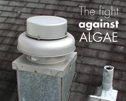Hexavalent chromium compounds are widely used in metal finishing, wood preservation, leather tanning, corrosion resistance and pigment production, among other uses. In the roofing industry, hexavalent chromium's presence is relatively rare and results most often from welding stainless-steel materials, which can yield inhalable hexavalent chromium.
Various epidemiological studies have reported increased risk of lung cancer among workers exposed to hexavalent chromium. As a result, you should be aware of these hazards and take steps to minimize exposure risks for your employees.
The risks
The general population can be exposed to hexavalent chromium through ambient air inhalation, water ingestion or skin contact with products containing the compound, such as some types of preservative-treated wood.
In addition, stainless steel contains at least 11.5 percent chromium. In roofing applications, stainless steel may be installed as siding panels, expansion joint covers, gutters, copings, counterflashings and, occasionally, roof decks. As a thin-gauge component of a roof system or accessory, stainless steel often is fastened by methods other than welding.
Typically, stainless steel's chromium element poses no risk to those who handle it. However, when stainless steel is arc welded, welders may be exposed to levels of hexavalent chromium as an inhalable fume or vapor.
The Occupational Safety and Health Administration (OSHA) has warned that, in addition to the lung cancer risk, workers exposed to high hexavalent chromium levels may suffer nose, throat and lung irritation, as well as irritation or damage to the eyes or skin. However, OSHA notes that inhaling small amounts of hexavalent chromium, even for long periods, does not cause respiratory irritation in most people. Some workers may develop an allergic reaction to hexavalent chromium and exhibit asthma-like symptoms when exposed.
Regulations and requirements
OSHA sets the permissible exposure limit (PEL) to hexavalent chromium at 5 micrograms per cubic meter of air as an eight-hour time-weighted average. Employers must perform initial air monitoring to calculate the eight-hour time-weighted average exposure by individual or representative samples. Air monitoring may be stopped if worker exposures are below 2.5 micrograms per cubic meter of air as an eight-hour time-weighted average.
Employers also may use historical or objective data to characterize worker exposures. For example, air-monitoring results from previous projects where workers performed similar tasks with similar materials and equipment could suffice to represent current exposure levels.
If hexavalant chromium levels exceed the PEL, employers must institute engineering and work-practice controls to reduce worker exposures. Respiratory protection must supplement the engineering and work-practice controls to ensure exposures are below the PEL.
OSHA's standard does not authorize job rotation to achieve compliance with the PEL for hexavalent chromium; in other words, you cannot rotate a worker's tasks to ensure he or she moves from one work area where hexavalent chromium levels likely exceed the PEL to a different work area where levels are low or nonexistent to manipulate that individual's time-weighted average calculation.
Also, workers may require personal protective equipment if skin or eye contact with hexavalent chromium is likely.
Rare but risky
Encountering hexavalent chromium in the roofing industry is rare. However, if you are involved with projects requiring welding of stainless-steel materials, you should be aware of OSHA's hexavalent chromium standard and train your employees about the element's risks and remedies.
Harry Dietz is NRCA's director of risk management.


